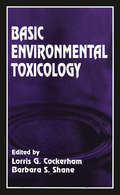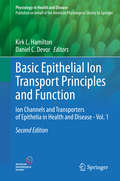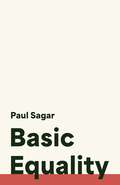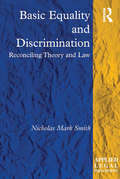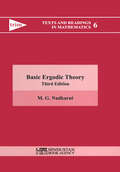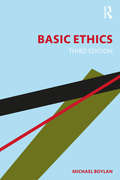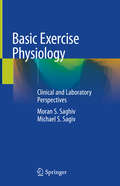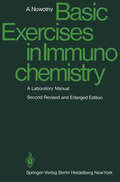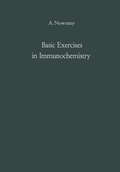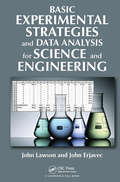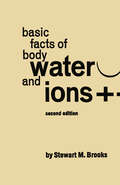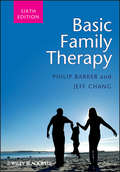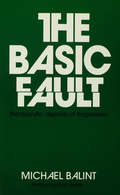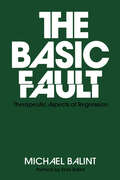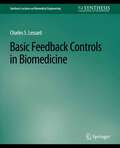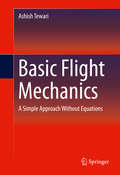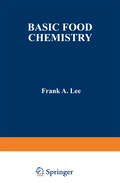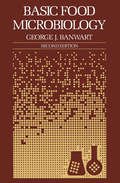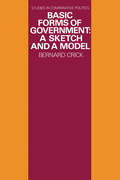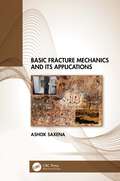- Table View
- List View
Basic Environmental Toxicology
by Lorris G. Cockerham Barbara S. ShaneBasic Environmental Toxicology provides a thorough, systematic introduction to environmental toxicology and addresses many of the effects of pollutants on humans, animals, and the environment. Readers are introduced to the fundamentals of toxicology and ecotoxicology, the effects of different types of toxicants, and how toxicants affect different compartments of the environment. Fundamental aspects of environmental health, occupational health, detection of pollutants, and risk assessment are discussed. The book is excellent for anyone involved in risk assessment or risk management, toxicologists, state and local public health officials, environmental engineers, industrial managers, consultants, and students taking environmental toxicology courses.
Basic Environmental Toxicology
by Lorris G. Cockerham Barbara S. ShaneBasic Environmental Toxicology provides a thorough, systematic introduction to environmental toxicology and addresses many of the effects of pollutants on humans, animals, and the environment. Readers are introduced to the fundamentals of toxicology and ecotoxicology, the effects of different types of toxicants, and how toxicants affect different compartments of the environment. Fundamental aspects of environmental health, occupational health, detection of pollutants, and risk assessment are discussed. The book is excellent for anyone involved in risk assessment or risk management, toxicologists, state and local public health officials, environmental engineers, industrial managers, consultants, and students taking environmental toxicology courses.
Basic Epithelial Ion Transport Principles and Function: Ion Channels and Transporters of Epithelia in Health and Disease - Vol. 1 (Physiology in Health and Disease)
by Kirk L. Hamilton Daniel C. DevorThis book discusses unique ion channels and transporters that are located within epithelial tissues of various organs including the kidney, intestine, pancreas and respiratory tract. As the authors show, these channels and transporters play crucial roles in transepithelial ion and fluid transport across epithelia and their contribution to maintaining homeostasis. Readers will be introduced to the fundamentals of ion transport in terms of function, modelling, regulation, structure and pharmacology. This is the first of three volumes highlighting the importance of epithelial ion channels and transporters in basic physiology and pathophysiology of human diseases. This volume focuses on basic fundamentals of epithelial transport physiology. There is a range of chapters dedicated to specific aspects of epithelial ion transport and cell function. Accordingly, the authors discuss techniques used to determine epithelial function, principles of epithelia transport, polarization of epithelial cells, mathematical modelling of epithelial ion transport, protein folding of ion channels, degradation epithelial ion channels, fundamentals of epithelial sodium, potassium and chloride transport, fundamentals of bicarbonate secretion, volume regulation, and microRNA regulation of epithelial channels and transporters. Given its scope, Volume 1 offers a valuable resource for physiology students, scientists and clinicians alike.
Basic Equality
by Paul SagarAn innovative argument that vindicates our normative commitment to basic equality, synthesising philosophy, history, and psychologyWhat makes human beings one another&’s equals? That we are "basic equals" has become a bedrock assumption in Western moral and political philosophy. And yet establishing why we ought to believe this claim has proved fiendishly difficult, floundering in the face of the many inequalities that characterise the human condition. In this provocative work, Paul Sagar offers a novel approach to explaining and justifying basic equality. Rather than attempting to find an independent foundation for basic equality, he argues, we should instead come to see our commitment to this idea as the result of the practice of treating others as equals. Moreover, he continues, it is not enough to grapple with the problem through philosophy alone—by just thinking very hard, in our armchairs; we must draw insights from history and psychology as well.Sagar writes that, as things stand, there appear to be no good arguments for believing in the truth of basic equality. Indeed, for much of Western intellectual history and social practice, basic inequality has been the default position. How is it then, Sagar asks, that in Western societies, in a period of less than a century, basic equality emerged as the dominant view? Sagar approaches this not as a mere philosophical puzzle, but as a dramatic historical development. In so doing, he shows us what is at stake when human beings treat one another as equals just because they are human beings.
Basic Equality and Discrimination: Reconciling Theory and Law
by Nicholas Mark SmithThe focus of this book is the idea of equality as a moral, political and jurisprudential concept. The author is motivated primarily by a concern to better understand conundrums in the justification, interpretation and application of discrimination law. Nicholas Smith aims to provide a clearer understanding of the nature of the value that the law is trying to uphold - equality. He rejects the notion that the concept of equality is vacuous and defends the idea as the proper range of moral concern. After discussing the general characteristics of the denial of equality and some types of discrimination, Smith considers prominent views on the point of equality law. He argues that human rights lawyers should step back from the business of trying to steer courts towards vague equality goals informed by conceptions of equality that are either empty or even more abstract than the notion of equality itself. If they do, Smith thinks that the meaning of 'equality' will be apparent, though abstract, and our difficulties will be shown to be, in the first instance, moral ones. These moral issues will require more rigorous attention before we can draft discrimination law which gives clear effect to a widely legitimate understanding of what it means to uphold and promote equality. This book will be a valuable resource for students and researchers working in the areas of legal philosophy, political theory, public law, and human rights law.
Basic Equality and Discrimination: Reconciling Theory and Law
by Nicholas Mark SmithThe focus of this book is the idea of equality as a moral, political and jurisprudential concept. The author is motivated primarily by a concern to better understand conundrums in the justification, interpretation and application of discrimination law. Nicholas Smith aims to provide a clearer understanding of the nature of the value that the law is trying to uphold - equality. He rejects the notion that the concept of equality is vacuous and defends the idea as the proper range of moral concern. After discussing the general characteristics of the denial of equality and some types of discrimination, Smith considers prominent views on the point of equality law. He argues that human rights lawyers should step back from the business of trying to steer courts towards vague equality goals informed by conceptions of equality that are either empty or even more abstract than the notion of equality itself. If they do, Smith thinks that the meaning of 'equality' will be apparent, though abstract, and our difficulties will be shown to be, in the first instance, moral ones. These moral issues will require more rigorous attention before we can draft discrimination law which gives clear effect to a widely legitimate understanding of what it means to uphold and promote equality. This book will be a valuable resource for students and researchers working in the areas of legal philosophy, political theory, public law, and human rights law.
Basic ergodic theory (Texts and Readings in Mathematics #6)
by M. G. NadkarniThis is an introductory book on Ergodic Theory. The presentation has a slow pace and the book can be read by any person with a background in basic measure theory and metric topology. A new feature of the book is that the basic topics of Ergodic Theory such as the Poincare recurrence lemma, induced automorphisms and Kakutani towers, compressibility and E. Hopf's theorem, the theorem of Ambrose on representation of flows are treated at the descriptive set-theoretic level before their measure-theoretic or topological versions are presented. In addition, topics around the Glimm-Effros theorem are discussed. In the third edition a chapter entitled 'Additional Topics' has been added. It gives Liouville's Theorem on the existence of invariant measure, entropy theory leading up to Kolmogorov-Sinai Theorem, and the topological dynamics proof of van der Waerden's theorem on arithmetical progressions.
Basic Ethics
by Michael BoylanBasic Ethics presents for a wide range of students and other interested readers the questions raised in thinking about ethical problems, the answers offered by moral philosophy, and the means to better integrate into both the reader’s world and personal life. It takes up what the author calls a "worldview theory," which shows readers how to begin with the values and understanding of the world that they already possess in order to transition from there to new levels of increasing ethical awareness. Updates to the third edition include the more thorough integration of feminist ethics into the principal theoretical traditions, a new chapter on the ethical responsibility to be well informed of current events, expanded coverage of human rights, and additional opportunities on how to use ethical reasoning in thinking about one’s own life and about public policy. Key Features: Links personal values to a philosophical treatment of the major ethical theories Presents ethics in the context of social/political issues that face our nation and the world Challenges the student to react to the presented material through critical exercises that may be used as weekly assignments and can form the basis of class discussion and evaluation. Engages the student to think about underlying issues first (in the basic questions) before presenting the most popular solutions (in the basic answers) Invites the reader to make up her own mind on how to formulate an ethical theory that will help her in her own life Offers a 16-chapter format to fit into most college-semester calendars Presents an overall structure that establishes foundational problems in ethical theory in the first section of the book that are variously addressed by the different ethical theories in the second section of the book Highlights key terms to help the reader grapple with issues raised (which are reviewed and defined in a final Glossary) Includes a final chapter designed to help students comprehend the book in its entirety. Updates to the Third Edition: Highlights new research on human rights and their relevance to ethical thinking and contemporary moral issues Integrates feminist ethics into the principal theoretical traditions: virtue ethics, ethical intuitionism, and some versions of deontology Provides new coverage of "fake news" and the moral responsibility to be well and accurately informed of current events Expands opportunities to use ethical reasoning in thinking about one’s own life and about public policy.
Basic Ethics
by Michael BoylanBasic Ethics presents for a wide range of students and other interested readers the questions raised in thinking about ethical problems, the answers offered by moral philosophy, and the means to better integrate into both the reader’s world and personal life. It takes up what the author calls a "worldview theory," which shows readers how to begin with the values and understanding of the world that they already possess in order to transition from there to new levels of increasing ethical awareness. Updates to the third edition include the more thorough integration of feminist ethics into the principal theoretical traditions, a new chapter on the ethical responsibility to be well informed of current events, expanded coverage of human rights, and additional opportunities on how to use ethical reasoning in thinking about one’s own life and about public policy. Key Features: Links personal values to a philosophical treatment of the major ethical theories Presents ethics in the context of social/political issues that face our nation and the world Challenges the student to react to the presented material through critical exercises that may be used as weekly assignments and can form the basis of class discussion and evaluation. Engages the student to think about underlying issues first (in the basic questions) before presenting the most popular solutions (in the basic answers) Invites the reader to make up her own mind on how to formulate an ethical theory that will help her in her own life Offers a 16-chapter format to fit into most college-semester calendars Presents an overall structure that establishes foundational problems in ethical theory in the first section of the book that are variously addressed by the different ethical theories in the second section of the book Highlights key terms to help the reader grapple with issues raised (which are reviewed and defined in a final Glossary) Includes a final chapter designed to help students comprehend the book in its entirety. Updates to the Third Edition: Highlights new research on human rights and their relevance to ethical thinking and contemporary moral issues Integrates feminist ethics into the principal theoretical traditions: virtue ethics, ethical intuitionism, and some versions of deontology Provides new coverage of "fake news" and the moral responsibility to be well and accurately informed of current events Expands opportunities to use ethical reasoning in thinking about one’s own life and about public policy.
Basic Exercise Physiology: Clinical and Laboratory Perspectives
by Moran S. Saghiv Michael S. SagivThis book reviews the assessment of human performance and the role of different exercise modes both in a laboratory and clinical setting. Details of how to successfully perform basic laboratory procedures for exercise training in health and disease, as well as how to apply non-invasive measurements in exercise physiology are provided. Chapters cover how to appropriately use a range of measures in assessing pulmonary function, anaerobic function and oxygen uptake. Techniques for cardiopulmonary rehabilitation and the mechanisms associated with thermoregulation are also described. Interactive exercises enable readers to easily assimilate key concepts and develop a thorough understanding of the topic. Basic Exercise Physiology provides both trainees and professional healthcare staff interested in exercise physiology with a detailed and practically applicable resource on the topic.
Basic Exercises in Immunochemistry: A Laboratory Manual
by A. NowotnyThis book intends to be neither a complete survey of the field nor an exhaustive source of references. For these purposes, the use of the extensive compilation "Experimental Immunochemistry" by E. A. KABAT and M. M. MAYER (1962) or the excellent methodological textbook, "Methods in Immunology", by D. H. CAMPBELL, J. S. GARVEY, E. E. CREMER and D. H. SUSSDORF (1963), or the quite comprehensive series "Methods in Immunology and Immunochemistry" by C. A. WILLIAMS and M. W. CHASE (1967) are more suitable. The main purpose of this manual ist to provide students with a simple book which will introduce them to some frequently occurring problems in the three major sections of the immunochemistry of natural products. These are the isolation of the materials, the chemical analysis of the constituents and their structure, and, finally, the assays of the most important biological and immunological activities. In this manual the exercises are simplified and several shortcuts are taken in order to fit them into the framework of a teaching course. The introduction to each exercise gives a brief and elementary explanation of the reaction on which it is based. "Materials and Equipment" lists all tissues or cells, chemicals, glassware, and special equipment which must be available to carry out the exercise, although the very common laboratory tools are usually omitted from the list.
Basic Experimental Strategies and Data Analysis for Science and Engineering
by John Lawson John ErjavecEvery technical investigation involving trial-and-error experimentation embodies a strategy for deciding what experiments to perform, when to quit, and how to interpret the data. This handbook presents several statistically derived strategies which are more efficient than any intuitive approach and will get the investigator to their goal with the fewest experiments, give the greatest degree of reliability to their conclusions, and keep the risk of overlooking something of practical importance to a minimum. Features: Provides a comprehensive desk reference on experimental design that will be useful to practitioners without extensive statistical knowledge Features a review of the necessary statistical prerequisites Presents a set of tables that allow readers to quickly access various experimental designs Includes a roadmap for where and when to use various experimental design strategies Shows compelling examples of each method discussed Illustrates how to reproduce results using several popular software packages on a companion web site Following the outlines and examples in this book should quickly allow a working professional or student to select the appropriate experimental design for a research problem at hand, follow the design to conduct the experiments, and analyze and interpret the resulting data. John Lawson and John Erjavec have a combined 25 years of industrial experience and over 40 years of academic experience. They have taught this material to numerous practicing engineers and scientists as well as undergraduate and graduate students.
Basic Experimental Strategies and Data Analysis for Science and Engineering
by John Lawson John ErjavecEvery technical investigation involving trial-and-error experimentation embodies a strategy for deciding what experiments to perform, when to quit, and how to interpret the data. This handbook presents several statistically derived strategies which are more efficient than any intuitive approach and will get the investigator to their goal with the fewest experiments, give the greatest degree of reliability to their conclusions, and keep the risk of overlooking something of practical importance to a minimum. Features: Provides a comprehensive desk reference on experimental design that will be useful to practitioners without extensive statistical knowledge Features a review of the necessary statistical prerequisites Presents a set of tables that allow readers to quickly access various experimental designs Includes a roadmap for where and when to use various experimental design strategies Shows compelling examples of each method discussed Illustrates how to reproduce results using several popular software packages on a companion web site Following the outlines and examples in this book should quickly allow a working professional or student to select the appropriate experimental design for a research problem at hand, follow the design to conduct the experiments, and analyze and interpret the resulting data. John Lawson and John Erjavec have a combined 25 years of industrial experience and over 40 years of academic experience. They have taught this material to numerous practicing engineers and scientists as well as undergraduate and graduate students.
Basic Family Therapy
by Philip Barker Jeff ChangThe challenge facing the authors of texts that address the multiplicity and complexity of problems that may afflict families can be intimidating. Philip Barker has addressed this challenge head-on in each of the editions of this book. This task has been greatly facilitated by the contributions of the new co-author, Jeff Chang, and in this edition provides a clear, easily read and readily understandable introduction to family therapy. Much has happened in the field of family therapy since the fifth edition of Basic Family Therapy was published in 2007. New developments covered in this book include: Emotionally Focused Therapy The Gottman approach to couples therapy Mindfulness and psychotherapy The common factors approach to psychotherapy and to family therapy The increased emphasis on empirically supported treatments High-conflict post-divorce parenting Basic Family Therapy will be of value to readers new to family therapy and to those in the early stages of training.
Basic Family Therapy
by Philip Barker Jeff ChangThe challenge facing the authors of texts that address the multiplicity and complexity of problems that may afflict families can be intimidating. Philip Barker has addressed this challenge head-on in each of the editions of this book. This task has been greatly facilitated by the contributions of the new co-author, Jeff Chang, and in this edition provides a clear, easily read and readily understandable introduction to family therapy. Much has happened in the field of family therapy since the fifth edition of Basic Family Therapy was published in 2007. New developments covered in this book include: Emotionally Focused Therapy The Gottman approach to couples therapy Mindfulness and psychotherapy The common factors approach to psychotherapy and to family therapy The increased emphasis on empirically supported treatments High-conflict post-divorce parenting Basic Family Therapy will be of value to readers new to family therapy and to those in the early stages of training.
The Basic Fault: Therapeutic Aspects of Regression
by Michael BalintIn this volume, Michael Balint, who over the years made a sustained and brilliant contribution to the theory and technique of psychoanalysis, develops the concept of the 'basic fault' in the bio-psychology structure of every individual, involving in varying degree both mind and body. Balint traces the origins of the basic fault to the early formative period, during which serious discrepancies arise between the needs of the individual and the care and nurture available. These Discrepancies create a kind of deficiency state.On the basis of this concept, Balint assumes the existence of a specific area of the mind in shich all the processes have an exclusively two-person structure consisting of the individual and the individual's primary object. Its dynamic force, originating from the basic fault has the overwhelming aim of 'putting things right'. This area is contrasted with two others: the area of the Oedipus complex, which has essentially a triangular structure comprising the individual and two of his objects, and whose characteristic dynamism has the form of a conflict; and the area of creation, in which there are no objects in the proper sense, and whose characteristic force is the urge to create, to produce
The Basic Fault: Therapeutic Aspects of Regression
by Michael BalintIn this volume, Michael Balint, who over the years made a sustained and brilliant contribution to the theory and technique of psychoanalysis, develops the concept of the 'basic fault' in the bio-psychology structure of every individual, involving in varying degree both mind and body. Balint traces the origins of the basic fault to the early formative period, during which serious discrepancies arise between the needs of the individual and the care and nurture available. These Discrepancies create a kind of deficiency state.On the basis of this concept, Balint assumes the existence of a specific area of the mind in shich all the processes have an exclusively two-person structure consisting of the individual and the individual's primary object. Its dynamic force, originating from the basic fault has the overwhelming aim of 'putting things right'. This area is contrasted with two others: the area of the Oedipus complex, which has essentially a triangular structure comprising the individual and two of his objects, and whose characteristic dynamism has the form of a conflict; and the area of creation, in which there are no objects in the proper sense, and whose characteristic force is the urge to create, to produce
Basic Feedback Controls in Biomedicine (Synthesis Lectures on Biomedical Engineering)
by Charles LessardThis textbook is intended for undergraduate students (juniors or seniors) in Biomedical Engineering, with the main goal of helping these students learn about classical control theory and its application in physiological systems. In addition, students should be able to apply the Laboratory Virtual Instrumentation Engineering Workbench (LabVIEW) Controls and Simulation Modules to mammalian physiology. The first four chapters review previous work on differential equations for electrical and mechanical systems. Chapters 5 through 8 present the general types and characteristics of feedback control systems and foot locus, frequency response, and analysis of stability and margins. Chapters 9 through 12 cover basic LabVIEW programming, the control module with its pallets, and the simulation module with its pallets. Chapters 13 through 17 present various physiological models with several LabVIEW control analyses. These chapters cover control of the heart (heart rate, stroke volume, and cardiac output), the vestibular system and its role in governing equilibrium and perceived orientation, vestibulo-ocular reflex in stabilizing an image on the surface of the retina during head movement, mechanical control models of human gait (walking movement), and the respiratory control model. The latter chapters (Chapters 13-17) combine details from my class lecture notes in regard to the application of LabVIEW control programming by the class to produce the control virtual instruments and graphical displays (root locus, Bode plots, and Nyquist plot). This textbook was developed in cooperation with National Instruments personnel. Table of Contents: Electrical System Equations / Mechanical Translation Systems / Mechanical Rotational Systems / Thermal Systems and Systems Representation / Characteristics and Types of Feedback Control Systems / Root Locus / Frequency Response Analysis / Stability and Margins / Introduction to LabVIEW / Control Design in LabVIEW / Simulation in LabVIEW / LabVIEW Control Design and Simulation Exercise / Cardiac Control / Vestibular Control System / Vestibulo-Ocular Control System / Gait and Stance Control System / Respiratory Control System
Basic Flight Mechanics: A Simple Approach Without Equations
by Ashish TewariThis book presents flight mechanics of aircraft, spacecraft, and rockets to technical and non-technical readers in simple terms and based purely on physical principles. Adapting an accessible and lucid writing style, the book retains the scientific authority and conceptual substance of an engineering textbook without requiring a background in physics or engineering mathematics. Professor Tewari explains relevant physical principles of flight by straightforward examples and meticulous diagrams and figures. Important aspects of both atmospheric and space flight mechanics are covered, including performance, stability and control, aeroelasticity, orbital mechanics, and altitude control. The book describes airplanes, gliders, rotary wing and flapping wing flight vehicles, rockets, and spacecraft and visualizes the essential principles using detailed illustration. It is an ideal resource for managers and technicians in the aerospace industry without engineering degrees, pilots, and anyone interested in the mechanics of flight.
Basic Food Chemistry
by Frank LeeFood chemistry has grown considerably since its early foundations were laid. This has been brought about not only by research in this field, but also, and more importantly, bYiadvances in the basic sciences involved. In this second edition, the chapters dealing with fundamentals have been rewritten and strengthened. Three new chapters have been added, Water and Solutions, Colloids, and Minerals. The chapter on Fruits and Vegetables has been expanded to cover texture. Other chapters discuss flavor and colors, together with one on brown ing reactions. The last seven chapters give the student a background of the classes offood products and beverages encountered in everyday use. Each chapter includes a summary and a list of references and sug gested readings to assist the student in study and to obtain further information. Basic Food Chemistry is intended for college undergraduates and for use in food laboratories. The author wishes to express his appreciation to the following people, who reviewed the chapters on their respective specialties: Doctors L.R. Hackler, M. Keeney, B. Love, L.M. Massey, Jr., L.R. Mattick, W.B. Robinson, R.S. Shallenberger,D.F. Splittstoesser, E. Stotz, W.L. Sulz bacher, and J. Van Buren. In addition, the author wishes to express his appreciation to Dr. H.O. Hultin and Dr. F.W. Knapp for their reviews of the entire original manuscript and for their helpful comments. The author welcomes notices of errors and omissions as well as sug gestions and constructive criticism.
Basic Food Microbiology (Food Science Text Series)
by George BanwartThe second edition of Basic Food Microbiology follows the same general outline as the highly successful first edition. The text has been revised and updated to include as much as possible of the large body of infor mation published since the first edition appeared. Hence, foodborne ill ness now includes listeriosis as well as expanded information about Campylobacter jejuni. Among the suggestions for altering the text was to include flow sheets for food processes. The production of dairy products and beer is now depicted with flow diagrams. In 1954, Herrington made the following statement regarding a review article about lipase that he published in thejournal of Dairy Science: "Some may feel that too much has been omitted; an equal number may feel that too much has been included. So be it." The author is grateful to his family for allowing him to spend the time required for composing this text. He is especially indebted to his partner, Sally, who gave assistance in typing, editing, and proofreading the manuscript. The author also thanks all of those people who allowed the use of their information in the text, tables, and figures. Without this aid, the book would not have been possible. 1 General Aspects of Food BASIC NEEDS Our basic needs include air that contains an adequate amount of oxy· gen, water that is potable, edible food, and shelter. Food provides us with a source of energy needed for work and for various chemical reactions.
Basic Forms of Government: A Sketch and a Model (pdf) (Studies in Comparative Politics)
by Bernard CrickBasic Fracture Mechanics and its Applications
by Ashok SaxenaThis textbook provides a comprehensive guide to fracture mechanics and its applications, providing an in-depth discussion of linear elastic fracture mechanics and a brief introduction to nonlinear fracture mechanics. It is an essential companion to the study of several disciplines such as aerospace, biomedical, civil, materials and mechanical engineering. This interdisciplinary textbook is also useful for professionals in several industries dealing with design and manufacturing of engineering materials and structures. Beginning with four foundational chapters, discussing the theory in depth, the book also presents specific aspects of how fracture mechanics is used to address fatigue crack growth, environment assisted cracking, and creep and creep-fatigue crack growth. Other topics include mixed-mode fracture and materials testing and selection for damage tolerant design, alongside in-depth discussions of ensuring structural integrity of components through real-world examples. There is a strong focus throughout the book on the practical applications of fracture mechanics. It provides a clear description of the theoretical aspects of fracture mechanics and also its limitations. Appendices provide additional background to ensure a comprehensive understanding and every chapter includes solved example problems and unsolved end of chapter problems. Additional instructor support materials are also available.
